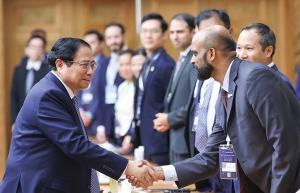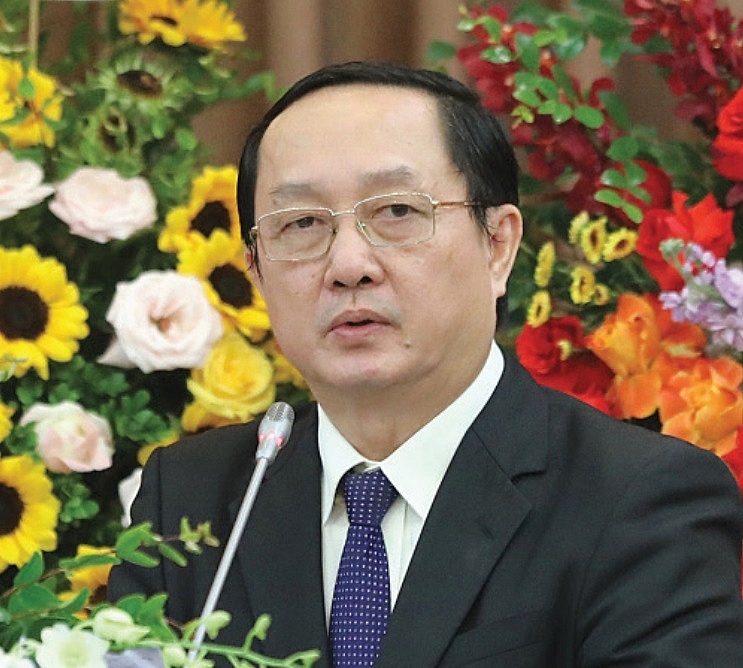FIEs approve of rankings for innovation
The business community welcomed Vietnam’s first publication of the Provincial Innovation Index (PII) on March 12, considering it an efficient tool for them when making investment. The index was piloted in 2022 in around 20 provinces and extended nationwide last year.
 |
With 52 indicators divided into seven pillars, the PII aims to provide a realistic picture of the current state of the socioeconomic development model based on sci-tech and innovation in each city and province. It will also provide grounds and evidence on strengths, weaknesses, potential factors, and necessary conditions to promote socioeconomic development based on sci-tech and innovation.
Alexander Ziehe, chairman of the German Business Association (GBA), told VIR, “We welcome initiatives that enhance transparency and provide detailed information for investors assessing potential locations. Indeed, factors such as innovation, the academic environment, and workforce competencies are typically included in the standard assessment process for investment sites.”
Takeo Nakajima, chief representative of the Japan External Trade Organization (JETRO) in Hanoi, said, “I congratulate Vietnam on publishing the PII for the first time. The Ministry of Science and Technology (MoST), related agencies, and localities spent many resources creating fair and transparent indexes. Local governments will target a comprehensive indicator of more than 50 factors, and investors will consider this when selecting a location.”
The MoST believes that the PII will be a useful reference for investors on the investment environment and potential for their production and business activities in localities.
Research and development (R&D), infrastructure, and market development are among the top concerns among foreign-invested enterprises, and Ziehe admitted that R&D and value chain advancement aligns with our shared goal of expanding the investor base.
Nguyen Quang Dong, director of the Institute for Policy Studies and Media Development, said, “There is still a lot of room for local governments to implement. Because the policy for digital and innovation services is still quite vague. The institutional environment for businesses to feel secure in doing business (procedures for establishing a business, product licensing, taxes, copyright protection) is still limited, making creators worried.”
The director noted that localities should not just look at innovation rankings. They should focus on others to increase their competitiveness. The most important thing about the PII is to help localities see weaknesses for improvement, thus contributing to improving the business climate.
Nakajima of JETRO added, “Although local governments could improve innovation rankings, there are many resources besides innovation to attract investors. Which regions are suitable for investment differs depending on what investors value. Understandably, Vietnam’s central and mountainous areas rank low in the index, but they can be attractive destinations for other investors.”
Ziehe of the GBA added that the PII is just one among numerous factors influencing foreign direct investment attraction and does not guarantee an increase in inflow. It is perceived more as a means to disseminate local knowledge.
“The primary criteria for decision-making continue to revolve around logistics, supply chain dynamics, proximity to customers, labour costs, and the level of support from local authorities,” he elaborated. “The interest of German companies in Vietnamese regions varies based on industry-specific supply chains.”
For example, Ho Chi Minh City and adjacent provinces are favoured due to an established network, skilled workforce, and the city’s status as Vietnam’s principal commercial centre. The region’s multiple seaports and robust industrial foundation make it attractive.
Elsewhere, northern Vietnam and the Hanoi-Haiphong corridor has gained traction recently due to its strategic connections to China, suppliers, and international markets. Meanwhile, Central Vietnam has drawn German investments lately, offering competitive advantages in cost, land availability, and workforce.
| Huynh Thanh Dat, minister of Science and Technology
Since 2017, the Global Innovation Index published annually by the World Intellectual Property Organization (WIPO) has been used by the government as an important tool for reference, development and promulgation of policies to promote innovation in Vietnam. At the local level, the government in 2022 assigned the Ministry of Science and Technology to preside and coordinate with the WIPO and relevant agencies to build a set of local innovation indicators and organise pilot assessments in a number of localities to measure innovation capacity and innovation results of each locality. In 2022, we successfully tested in 20 localities. On that basis, the government assigned us to officially deploy the PII nationwide. The index provides scientific and practical bases for agencies, organisations, and individuals to use as they build and implement policies to promote local socioeconomic development based on science, technology, and innovation. It will be a useful reference for investors for their business activities in each locality. The ministry hopes to continue receiving support from ministries, agencies, localities, and international organisations to ameliorate and carry out the PII every year as assigned by the government with a view to improving the domestic business environment and enhance national competitiveness. Vu Van Tich, director Vietnam Institute of Science Technology and Innovation
The PII is an index that integrates many indexes of many other ministries and agencies. This is a tool to check the health of the economy associated with science, technology and innovation activities. This is an important set of indicators, measuring the economic development in the transition from an agriculture-based economy to an innovation-driven economy. Learning experience from developed countries such as China, South Korea, and Japan, this set of indicators is a framework to manage socioeconomic activities, and investment initiatives in localities, as well as manage how we have mechanisms to attract more investment in innovation, and technology infrastructure and pay more attention to people in the context of rapid sci-tech development, especially AI technology. With this index, cities and provinces will have to pay more attention to their policies, products and services, helping to develop local development strategies based on sci-tech in the future. Kenneth Loh, vice president Singapore Chamber of Commerce in Hanoi
The PII serves to provide an overview of the socioeconomic development of each province, based on science, technology, and innovation. Those provinces with high PII possess favourable natural and geographical attributes in general, while the lower ranking provinces lack the same ingredients found in provinces with a high PII. The PII can be a valuable tool for new Singaporean investors and companies looking to invest in Vietnam. The PII ranks Vietnamese provinces based on their innovation capabilities. The index likely considers factors like existing industry clusters and areas of research focus within each province. Singaporean companies can use this information to align their investment strategy with a province’s existing strengths. A strong PII ranking might indicate a province with a vibrant innovation ecosystem. This could make it easier for Singaporean companies to find local partners with the necessary expertise and connections to navigate the Vietnamese market. While the PII can serve as a reference in making the initial screening and investment orientation, it is by no means the sole factor of consideration. As for incumbent Singaporean companies, the PII was unavailable for them to make reference in their decision-making process, and they made their decisions based on market research and due diligence. Thus, it is no coincidence that the provinces attracted the most Singaporean investors are those listed in the top ranks of the PII, due mainly to their strong attributes in science, technology, and innovation. Takeo Nakajima, chief representative Japan External Trade Organization in Hanoi
Innovation indicators tend to be heavily weighted towards large cities. They attract universities, research, funds, technologies, and human resources. However, there is tight competition. If you want to collaborate with a university, doing so with a top university may be challenging. Large and emerging cities suit companies targeting taking markets and skilled human resources. On the other hand, industries such as manufacturing, energy, agriculture, tourism, and logistics often target regional cities. Fifteen years ago, manufacturing industries also had bases in Hanoi and Ho Chi Minh City, but now it is not practical to find manufacturing within big cities. In the north, investments spread to Hai Duong, Hung Yen, Ha Nam, and Binh Phuc, and now it has further expanded to Thanh Hoa, Nam Dinh, and Quang Ninh. Expressways reach rural areas, and industrial parks are under development in various regions. These areas offer potential for a sufficient supply of human resources. Incomes of people in rural areas are also increasing. Rural areas also attract projects in agriculture, tourism, energy, and more. Enterprises will direct their investments to the appropriate regions, leading to diversification of Vietnam’s investment climate. |
 | Government and enterprises outline efforts to implement green growth strategies at VBF 2024 The Vietnam Business Forum (VBF 2024) took place this morning in Hanoi, themed "FDI enterprises pioneer in implementing green growth strategies" and chaired by Prime Minister Pham Minh Chinh. |
 | Game-changing ESG initiatives expected With the Vietnamese government last week boosting commitments to supporting foreign-invested enterprises, more green business and funding initiatives are expected in the coming months. |
 | Project procedures must be truncated A number of obstacles in administrative procedures, especially in granting business licences, are hindering the market entry of businesses in Vietnam. |
What the stars mean:
★ Poor ★ ★ Promising ★★★ Good ★★★★ Very good ★★★★★ Exceptional
Related Contents
Latest News
More News
- Businesses ramp up production as year-end orders surge (December 30, 2025 | 10:05)
- Vietjet chairwoman awarded Labour Hero title (December 29, 2025 | 13:06)
- How to unlock ESG value through green innovation (December 29, 2025 | 10:03)
- AI reshapes media and advertising industry (December 29, 2025 | 08:33)
- FPT and GELEX sign deal to develop blockchain tech for global markets (December 29, 2025 | 08:29)
- Vietnam’s GDP forecast to grow by 9 per cent in 2026 (December 29, 2025 | 08:29)
- Women entrepreneurs are key to Vietnam’s economic growth (December 29, 2025 | 08:00)
- Vietnam's top 500 value-creating enterprises announced (December 27, 2025 | 08:00)
- The PAN Group shaping a better future with ESG strategy (December 26, 2025 | 09:00)
- Masan Consumer officially lists on HSX, marking the next phase of value creation (December 25, 2025 | 13:20)





 Tag:
Tag:





















 Mobile Version
Mobile Version